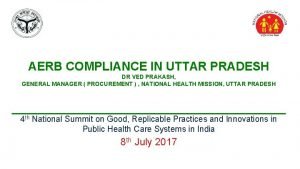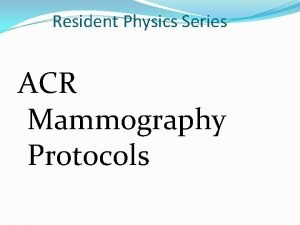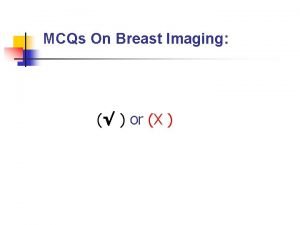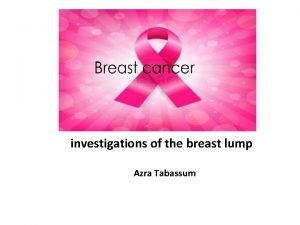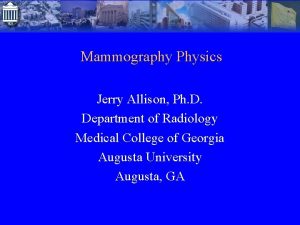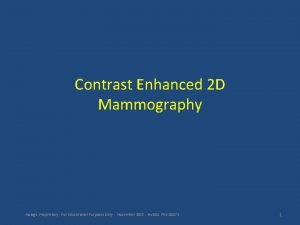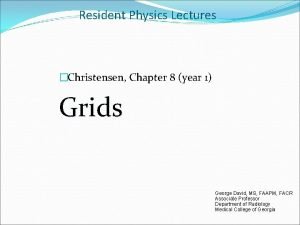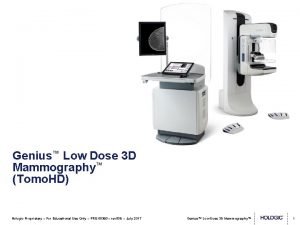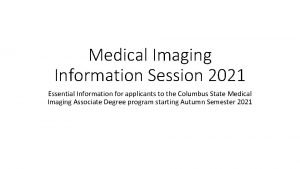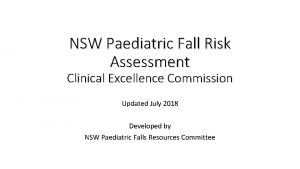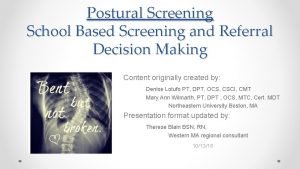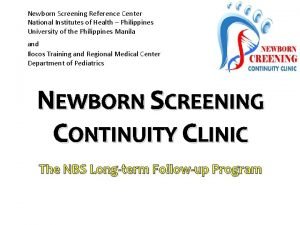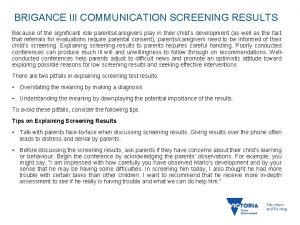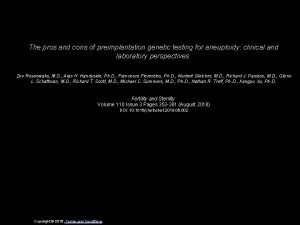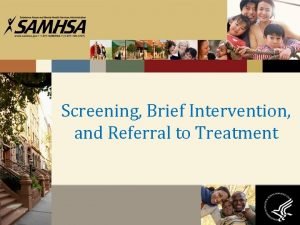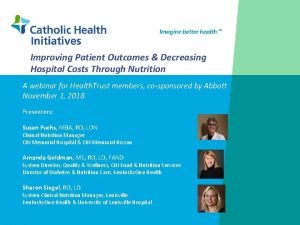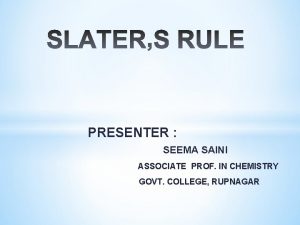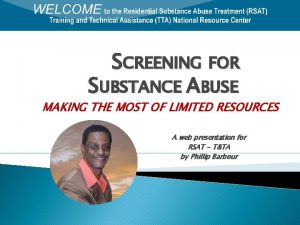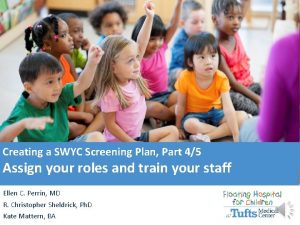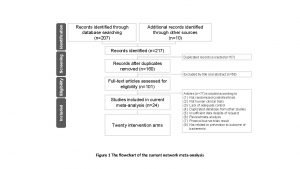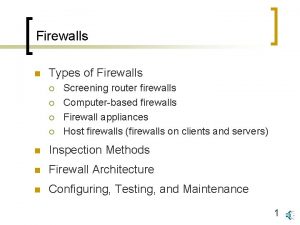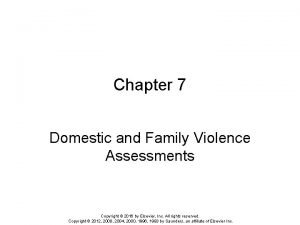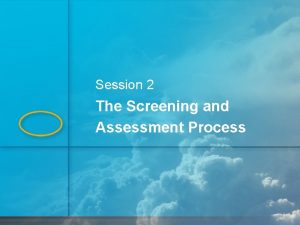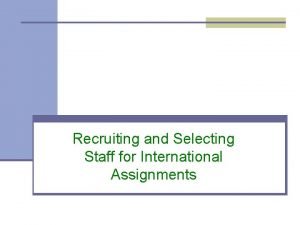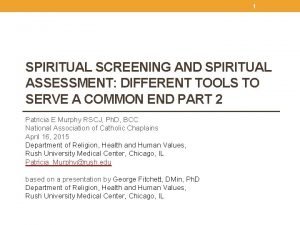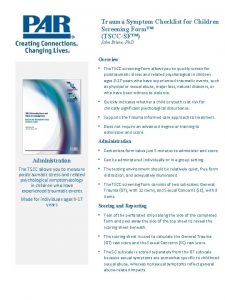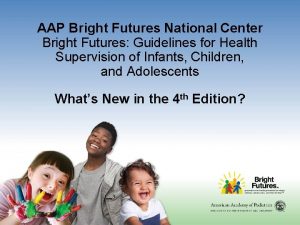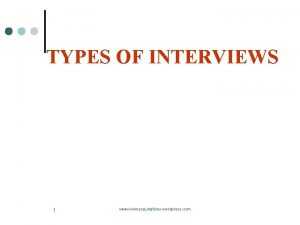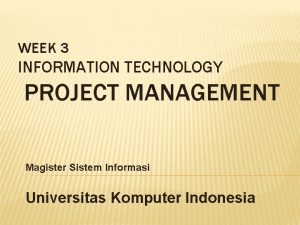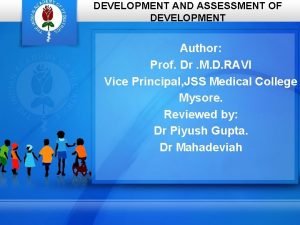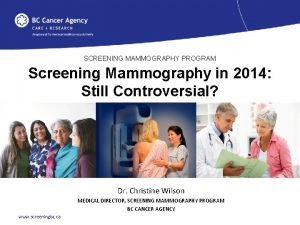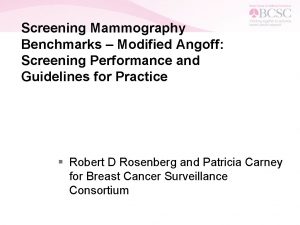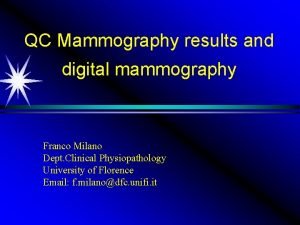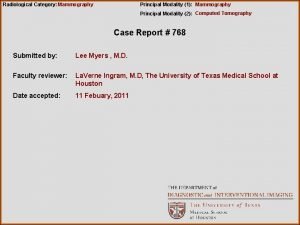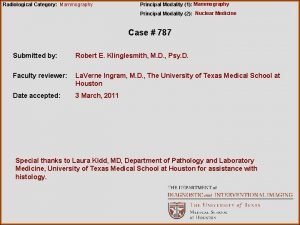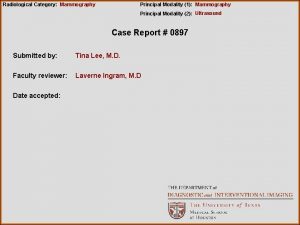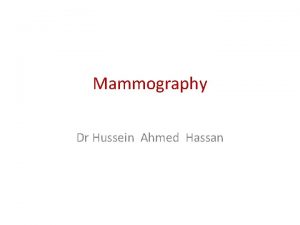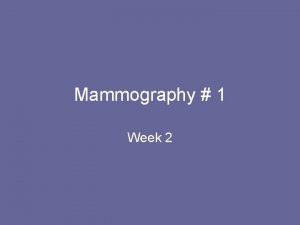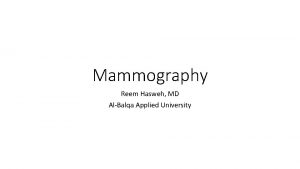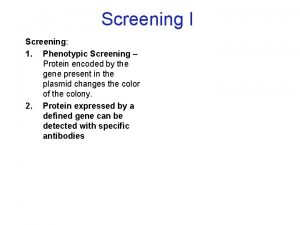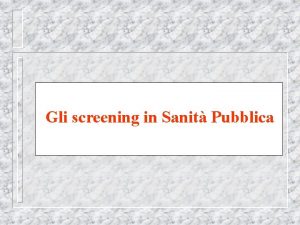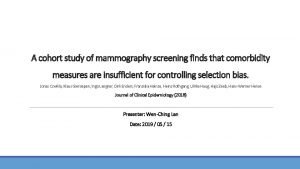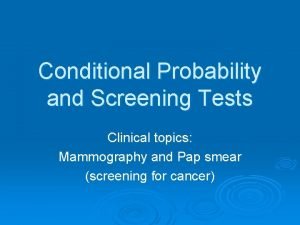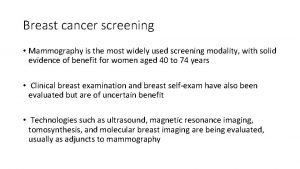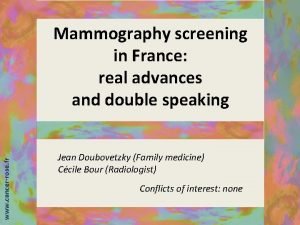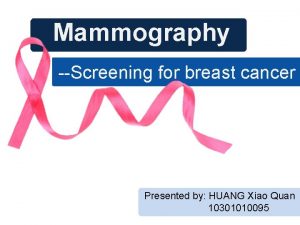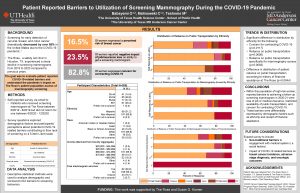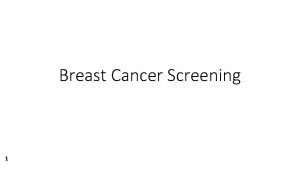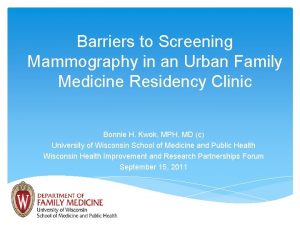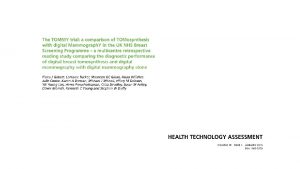Screening Mammography Update 2017 Gaelyn Scuderi M D













































- Slides: 45

Screening Mammography Update 2017 Gaelyn Scuderi, M. D. Diagnostic Radiologist Breast Imaging and Intervention

Disclosures: I have no disclosures or conflicts of interest related to this presentation.

Objectives § Summarize the current controversies surrounding screening mammography. § Outline existing recommendations for screening mammography. § Define parameters for usage of supplemental screening modalities.

Screening Mammography Guidelines § American College of Radiology (ACR) § Society of Breast Imaging (SBI) § American Cancer Society (ACS) § US Preventative Services Task Force (USPSTF) ACR/SBI More conservative ACS USPSTF Multiple Guidelines Less conservative

RISK vs. BENEFIT

Controversies in Screening Mammography BENEFITS § Mortality Reduction § Since institution of widespread mammography screening in the 1980’s, US breast cancer death rate has declined by approximately 30%

Controversies in Screening Mammography BENEFITS § Mortality Reduction § Absolute mortality benefit is subject of hot debate § American Cancer Society (ACS) and the American College of Radiology/Society of Breast Imaging (ACR/SBI) agree : § Up to 48% in women actually screened § Pooled mortality reduction 28 -36% in trend studies § 25% for invited and 38% for screened in cohort studies § 31% for invited and 48% for screened in case-control studies

Controversies in Screening Mammography BENEFITS § Mortality Reduction § ACR/SBI, ACS, and USPSTF all cite data which shows that the most lives saved by screening mammography occur when women begin annual screening at age 40 § Breast cancer incidence noticeably increases at age 40 § Incidence of breast cancer at age 40 is 2 x for ages 35 -39 § 1 in 6 breast cancers occur in women in their 40’s § Incidence continues to rise until age 80

Controversies in Screening Mammography RISKS Overdiagnosis False Positive Mammogram False Negative Mammogram

Controversies in Screening Mammography RISKS § Overdiagnosis § Detection of cancer by a screening methodology that would otherwise not have been detected within the person’s lifetime § Excess incidence of breast cancer over time in a group exposed to screening versus a group not exposed to screening § “Most serious concern”

Controversies in Screening Mammography RISKS § Overdiagnosis § Difficult to reliably quantify § Invasive cancers only vs. invasive cancers + DCIS § Adjust for lead time, trends in incidence, selection bias, etc. § Reported rate is widely varied: 5 -50% § SBI: 10% § ACS: it’s there, but no reliable data for magnitude § USPSTF: 10 -19%, possibly higher

Controversies in Screening Mammography

Controversies in Screening Mammography

Controversies in Screening Mammography RISKS § Overdiagnosis § ACR/SBI and ACS agree: § Overdiagnosis is real § Reported rates of overdiagnosis are overinflated due to statistical and methodological flaws/inconsistencies § DCIS accounts for most if not all overdiagnosed breast malignancies § Currently, no prospective way for us to know which cancers will prove life threatening and which will not

Controversies in Screening Mammography RISKS § False positive exam § What constitutes a false positive? § Screening diagnostic screening § Screening diagnostic negative biopsy § Concern raised for long-term psychosocial harm § Ann Fam Med, 2013: up to 3 years of negative psychosocial consequences § JAMA Intern Med, 2014: no significant long term anxiety

Controversies in Screening Mammography RISKS § False positive exam § For a women undergoing screening from age 4050 yrs § False positive recall § 61. 3% with annual mammography § 41. 6% with biennial mammography § False positive biopsy § 7% with annual mammography § 4. 8% with biennial mammography

Controversies in Screening Mammography RISKS § False negative exam (“Happy Gram”) § Increased breast density makes mammographic detection of malignancy more difficult § Breast density = proportion of fat to gland § Almost entirely fatty § Scattered fibroglandular densities § Heterogeneously dense which may obscure small masses § Extremely dense

Almost Entirely Fatty

Scattered Fibroglandular Densities

Heterogeneously Dense

Extremely Dense

Controversies in Screening Mammography RISKS § False negative exam (“Happy Gram”) § Dense breasts § Masking effect § Digital Mammography improves false negative rate compared to screen film § Increased risk of breast malignancy with increased breast density § Heterogeneously dense: RR 1. 2 § Extremely dense: RR 2. 1 § Supplemental screening?

www. areyoudense. org

Controversies in Screening Mammography Breast Density § Relative risk of breast density is much smaller than other major risk factors for breast cancer § § Age Family history Reproductive history Known genetic mutations § Mammography is a keystone imaging modality § Supplemental screening modalities should never substitute for screening mammography

Controversies in Screening Mammography Breast Density § High risk women (>20% lifetime risk) § Supplemental screening with annual breast MRI, regardless of breast density § Performed at six month intervals to screening mammography § Endorsed by multiple groups: § § § American Cancer Society (ACS) National Comprehensive Cancer Network (NCCN) American College of Radiology/Society of Breast Imaging (ACR/SBI) § American Society of Breast Surgeons (ASBS)

Controversies in Screening Mammography Breast Density § Intermediate-risk women § 15 -20% lifetime risk § ACS: Not enough information to recommend for or against yearly supplemental screening MRI § Average-risk women § Supplemental screening in women who are of average or low risk is not currently recommended by most major medical societies or evidence-based review studies, regardless of breast density

Controversies in Screening Mammography Breast Density § Whole breast screening ultrasound § No additional value added in high-risk women who can undergo supplemental screening breast MRI § If breast MRI contraindicated (pacemaker, contrast allergy, lack of vascular access), then whole breast supplemental screening ultrasound may be considered § § § Incremental cancer detection rate 2. 5 -5. 3/1000 PPV 3 is extremely low: 6 -7% Recall rate estimated 2 x compared to mammography § Biopsy rate 3 x compared to mammography

Screening Mammography Guidelines § American College of Radiology (ACR) § Society of Breast Imaging (SBI) § American Cancer Society (ACS) § US Preventative Services Task Force (USPSTF) ACR/SBI More conservative ACS USPSTF Multiple Guidelines Less conservative

Screening Mammography Guidelines American College of Radiology and Society of Breast Imaging § Yearly screening beginning at age 40 for average risk females

Screening Mammography Guidelines American College of Radiology and Society of Breast Imaging § Yearly screening beginning at age 40 for average risk females § Yearly screening beginning at age 30 for females with 20% or greater lifetime risk § § BRCA 1 or 2 positive family history risk calculation premenopausal first degree relative or ten years earlier than the youngest family member diagnosed with breast malignancy, not before age 25 § Yearly within 8 years of mantle irradiation (≥ 25 yrs) § Yearly in all women with biopsy-proven breast cancer or ovarian cancer

Screening Mammography Guidelines American College of Radiology and Society of Breast Imaging § Continue screening indefinitely as long as: § 5 -7 years of remaining life expectancy § Willing to undergo additional testing (biopsy) and at least limited treatment

Screening Mammography Guidelines American Cancer Society § Yearly screening from ages 45 -54 for average risk females § Access to annual screening for women 40 -44 years

Screening Mammography Guidelines American Cancer Society § Biennial screening in women >55 years for average risk females OR § Access to annual screening

Screening Mammography Guidelines American Cancer Society Continue screening indefinitely as long as life expectancy is 10 years or longer

Screening Mammography Guidelines USPSTF Biennial screening mammography for women 50 -74 years. § Grade B

Screening Mammography Guidelines USPSTF High risk women (known first degree relative with breast cancer) may consider initiating screening at age earlier than 50 years. § Grade C

Screening Mammography Guidelines USPSTF Current evidence is insufficient to assess balance of benefits versus harms of screening mammography in women ≥ 75 yrs § Grade I

Controversies in Screening Mammography § Why do the USPSTF recommendations matter? § Intense criticism of USPSTF methodology § No clinician involved in women’s breast health or cancer care was on the panel § Decisions were made on a limited number of selected studies, many of which were contested § by contrast, ACS used widely accepted IOM guideline development process § Development and revision process was closed to input from all stakeholders

Controversies in Screening Mammography § Why do the USPSTF recommendations matter? § Hendrick and Helvie, 2011, AJR § Preventable loss of life § Annual screening at age 40 saves 6, 500 more lives a year in the US than USPSTF’s proposed biennial screening beginning at age 50

Controversies in Screening Mammography § How will USPSTF impact patient care? Women’s Preventative Services Initiative (WPSI) § Recommendations § § § Begin screening no earlier than 40 and no later than 50 At least biennial and up to annual frequency Continue screening until at least age 74 § Age alone should not determine cessation of screening § Recommendations apply only to women of average risk § High risk screening considered beyond scope of the WPSI 2019

Screening Mammography Update 2017 Take Home Points for the Primary Care Physician § Screening mammography like all medical tests has RISKS and BENEFITS § Major benefit: § 30% reduction in death from breast cancer § Risks: § § § Overdiagnosis (mostly DCIS) False Positive (diagnostic workup or biopsy that is neg for cancer) False Negative (Happy. Gram aka breast density) § Risk stratification of patients is KEY § High risk patients need annual mammography and supplemental screening § Maximum mortality reduction benefit = annual screening beginning at age 40 § Tradeoff = potential increase in false positive exams

References Oeffinger KC, Fontham EH, Etzioni R, et al. Breast Cancer Screening for Women at Average Risk: 2015 Guideline Update From the American Cancer Society. JAMA. 2015; 314(15): 1599 -1614. doi: 10. 1001/jama. 2015. 12783. . Cancer Society. JAMA. 2015; 314(15): 1599 -1614. doi: 10. 1001/jama. 2015. 12783 Lee CH, Dershaw DD, Kopans D, Evans P, Monsees B, Monticciolo D, et al. . Breast cancer screening with imaging: recommendations from the Society of Breast Imaging and the ACR on the use of mammography, breast MRI, breast ultrasound, and other technologies for the detection of clinically occult breast cancer. J Am Coll Radiol. 2010; 7: 18 -27. Siu AL, U. S. Preventive Services Task Force. Screening for breast cancer: U. S. Preventive Services Task Force recommendation statement. Ann Intern Med. 2016; 164: 279 -96. Sickles, EA, D’Orsi CJ, Bassett LW, et al. ACR BI-RADS® Mammography. In: ACR BI-RADS® Atlas, Breast Imaging Reporting and Data System. Reston, VA, American College of Radiology; 2013. Hellquist, B. N. , Duffy, S. W. , Abdsaleh, S. , Björneld, L. , Bordás, P. , Tabár, L. , Viták, B. , Zackrisson, S. , Nyström, L. and Jonsson, H. (2011), Effectiveness of population-based service screening with mammography for women ages 40 to 49 years. Cancer, 117: 714– 722. doi: 10. 1002/cncr. 25650 Tabár L, Vitak B, Chen TH-H, Yen AM-F, Cohen A, Tot T, et al. Swedish two-county trial: impact of mammographic screening on breast cancer mortality during 3 decades. Radiology. 2011; 260(3): 658– 63. doi: 10. 1148/ radiol. 11110469 Berg WA, Blume JD, Cormack JB, et al. Combined screening with ultrasound and mammography vs mammography alone in women at elevated risk of breast cancer. JAMA 2008; 299(18): 2151– 2163. Myers ER, Moorman P, Gierisch JM, Havrilesky L, Grimm L, Ghate S, et al. Benefits and Harms of Breast Cancer Screening: A Systematic Review. JAMA. 2015

References Smith, R. A. Counterpoint: overdiagnosis in breast cancer screening. J Am Coll Radiol. 2014; 11: 648– 652. . Smith, R. A. Counterpoint: overdiagnosis in breast cancer screening. J Am Coll Radiol Hubbard RA, Kerlikowske K, Flowers CI, et al. Cumulative probability of false-positive recall or biopsy recommendation after 10 years of screening mammography: a cohort study. Ann Intern Med. 2011; 155(8): 481 -492. . screening mammography: a cohort study. Ann Intern Med. 2011; 155(8): 481 -492 Broderson J and Siersma VD. Long-Term Psychosocial Consequences of False-Positive Screening Mammography. Ann Fam Med. March/April 2013; 11: 106 -115; doi: 10. 1370/afm. 1466. Tosteson AA, Fryback DG, Hammond CS, et al. Consequences of False-Positive Screening Mammograms. JAMA Intern Med. 2014; 174(6): 954 Tosteson AA, Fryback DG, Hammond CS, et al. Consequences of False-Positive Screening Mammograms. JAMA Intern Med. 2014; 174(6): 954961. doi: 10. 1001/jamainternmed. 2014. 981. Friedewald SM, Rafferty EA, Rose SL, et al. Breast cancer screening using tomosynthesis in combination with digital mammography. JAMA. 2014; 311(24): 2499– 507. Rose SL, Tidwell AL, Bujnoch LJ, et al. Implementation of breast tomosynthesis in a routine screening practice: an observational study. AJR Am J Roentgenol. 2013; 200(6): 1401– 8. Skaane P, Bandos AI, Gullien R, et al. Comparison of digital mammography alone and digital mammography plus tomosynthesis in a populationbased screening program. Radiology. 2013; 267(1): 47– 56. Freer PE. Mammographic breast density: impact on breast cancer risk and implications for screening. Radio. Graphics 2015; 35: 302– 315 Mandelblatt JS, Cronin KA, Bailey S, et al; Breast Cancer Working Group of the Cancer Intervention and Surveillance Modeling Network. Effects of mammography screening under different screening schedules: model estimates of potential benefits and harms. Ann Intern Med. 2009; 151(10): 738 -747.

References "Are You Dense Advocacy | D. E. N. S. E. ®. " Are You Dense Advocacy | D. E. N. S. E. ®. Web. 14 Jan 2017. Are You Dense Advocacy | D. E. N. S. E. ®. " Are You Dense Advocacy | D. E. N. S. E. ®. Web. Surveillance, Epidemiology, and End Results Program. (n. d. ). Retrieved April 23, 2016, from http: //seer. cancer. gov/statfacts/html/ breast. html. Surveillance, Epidemiology, and End Results Program. (n. d. ). Retrieved April 23, 2016, from http: //seer. cancer. gov/statfacts/html/breast. html. "Provider Resources. End The Confusion ACR/SBI Talking Points: ACS Mammography Guidelines. ” Society of Breast Imaging. retrieved 23 Apr. 2016 from http: //www. sbi-online. org/Portals/1/Position%20 Statements/ACS/ACR%20 SBI%20 TPs%20 for%20 ACS%20 Final. pdf. "Provider Resources. ACR Mammography Study Brief. ” Society of Breast Imaging. retrieved 25 Apr. 2016 from https: //www. sbionline. org/Portals/1/Position%20 Statements/ACS/ACR%20 Mammography%20 Study%20 Brief. pdf. Evidence Summary: Harms of Screening for Breast Cancer. (n. d. ). Retrieved April 23, 2016, from http: //www. uspreventiveservicestaskforce. org/Page/Document/evidence-summary-harms-of-screening-for-breast-cancer/breast-cancerscreening 1. Women’s Preventative Services Guidelines. Retrieved 14 Jan 2017 from https: //www. hrsa. gov/womensguidelines 2016 /. Women’s Preventative Services Guidelines. Retrieved 14 Jan 2017 from https: //www. hrsa. gov/womensguidelines 2016/. HRSA Takes Next Step in Updating the Women’s Preventative Services Guidelines. 20 Dec 2016. Retrieved 14 Jan 2017 from https: //www. hrsa. gov/about/news/pressreleases/ 161220 womensguidelinesupdates. html. https: //www. hrsa. gov/about/news/pressreleases/161220 womensguidelinesupdates. html. ACR and SBI Support Mammography Insurance Coverage Required by New HRSA Breast Cancer Screening Guidelines. 22 Dec 2016. . ACR and SBI Support Mammography Insurance Coverage Required by New HRSA Breast Cancer Screening Guidelines. 22 Dec 2016 Retrieved 14 Jan 2017 from https: //www. sbi-online. org/Portals/0/Position%20 Statements/HRSA%20 Requires%20 Mammo%20 Coverage. pdf. . Retrieved 14 Jan 2017 from https: //www. sbi-online. org/Portals/0/Position%20 Statements/HRSA%20 Requires%20 Mammo%20 Coverage. pdf Conant, Emily and Philpotts, Liane. September 2016. White Paper, Digital Breast Tomosynthesis for Screening and Diagnostic Imaging. Retrieved 16 Jan 2017 from http: //www. sbionline. org/Portals/0/White%20 Papers/Digital %20 Breast%20 Tomosynthesis%20 for%20 Screening%20 and%20 Diagnostic%20 Imagingonline. org/Portals/0/White%20 Papers/Digital%20 Breast%20 Tomosynthesis%20 for%20 Screening%20 and% September%202016. pdf.

References Berg, Wendie and Harvey, Jennifer. September 2016. White Paper, Breast Density and Supplemental Screening. Retrieved 14 Jan 2017 from http: //www. sbi-online. org/Portals/0/White%20 Papers/Breast%20 Density%20 and%20 Supplemental%20 Screening_Sept%202016. pdf. Women’s Preventative Services Initiative (WPSI). Retrieved 14 Jan 2017 from http: //www. acog. org/About-ACOG/ACOG-Departments/Annual. Women’s Preventative Services Initiative (WPSI). Retrieved 14 Jan 2017 Womens-Health-Care/Womens-Preventive-Services-Initiative. Jørgensen KJ, Gøtzsche PC, Kalager M, Zahl P. Breast Cancer Screening in Denmark: A Cohort Study of Tumor Size and Overdiagnosis. Ann Intern Med. [Epub ahead of print 10 January 2017] doi: 10. 7326/M 16 -0270. Njor, SH, Olsen AH, Blichert-Toft M, et al. Overdiagnosis in Screening Mammography in Denmark: Population Based Cohort Study. BMJ 2013; 346: f 1064.
 What is an alternative of log based recovery
What is an alternative of log based recovery Mammography
Mammography Mqsa requirements for mammography checklist
Mqsa requirements for mammography checklist Mammography mcqs
Mammography mcqs Cleopatra view mammography
Cleopatra view mammography Components of mammography machine
Components of mammography machine Htc grid mammography
Htc grid mammography Hologic contrast enhanced mammography
Hologic contrast enhanced mammography Upside down focused grid
Upside down focused grid Tomo hd
Tomo hd Mammo qc
Mammo qc Cscc medical imaging
Cscc medical imaging Falls risk assessment nsw
Falls risk assessment nsw Risser score scoliosis
Risser score scoliosis Newborn screening reference center
Newborn screening reference center Brigance screening test
Brigance screening test Preimplantation genetic screening pros and cons
Preimplantation genetic screening pros and cons Crafft screening tool
Crafft screening tool Linda silverman screening
Linda silverman screening Mst screening
Mst screening Mass_947
Mass_947 Audit c screening
Audit c screening Slater rule and its applications
Slater rule and its applications Simple screening instrument for substance abuse
Simple screening instrument for substance abuse Swyc screening
Swyc screening Identification screening eligibility included
Identification screening eligibility included Rock +screening
Rock +screening Esir screening
Esir screening Screening router
Screening router Case diagram in software engineering
Case diagram in software engineering Shower approach marketing
Shower approach marketing Routine, universal screening for domestic violence means
Routine, universal screening for domestic violence means Screening session
Screening session Indirect cost of expatriate failure
Indirect cost of expatriate failure Is electrodermal screening legitimate
Is electrodermal screening legitimate George fitchett 7x7 model
George fitchett 7x7 model Tscc screening form
Tscc screening form Evaluating opportunities in the changing market environment
Evaluating opportunities in the changing market environment Bright futures screening guidelines
Bright futures screening guidelines Example of briefing
Example of briefing Background screening clearinghouse login
Background screening clearinghouse login Contoh new product development
Contoh new product development Discounted payback period
Discounted payback period What is a screening interview
What is a screening interview Magister project management
Magister project management Trivandrum developmental screening chart
Trivandrum developmental screening chart

